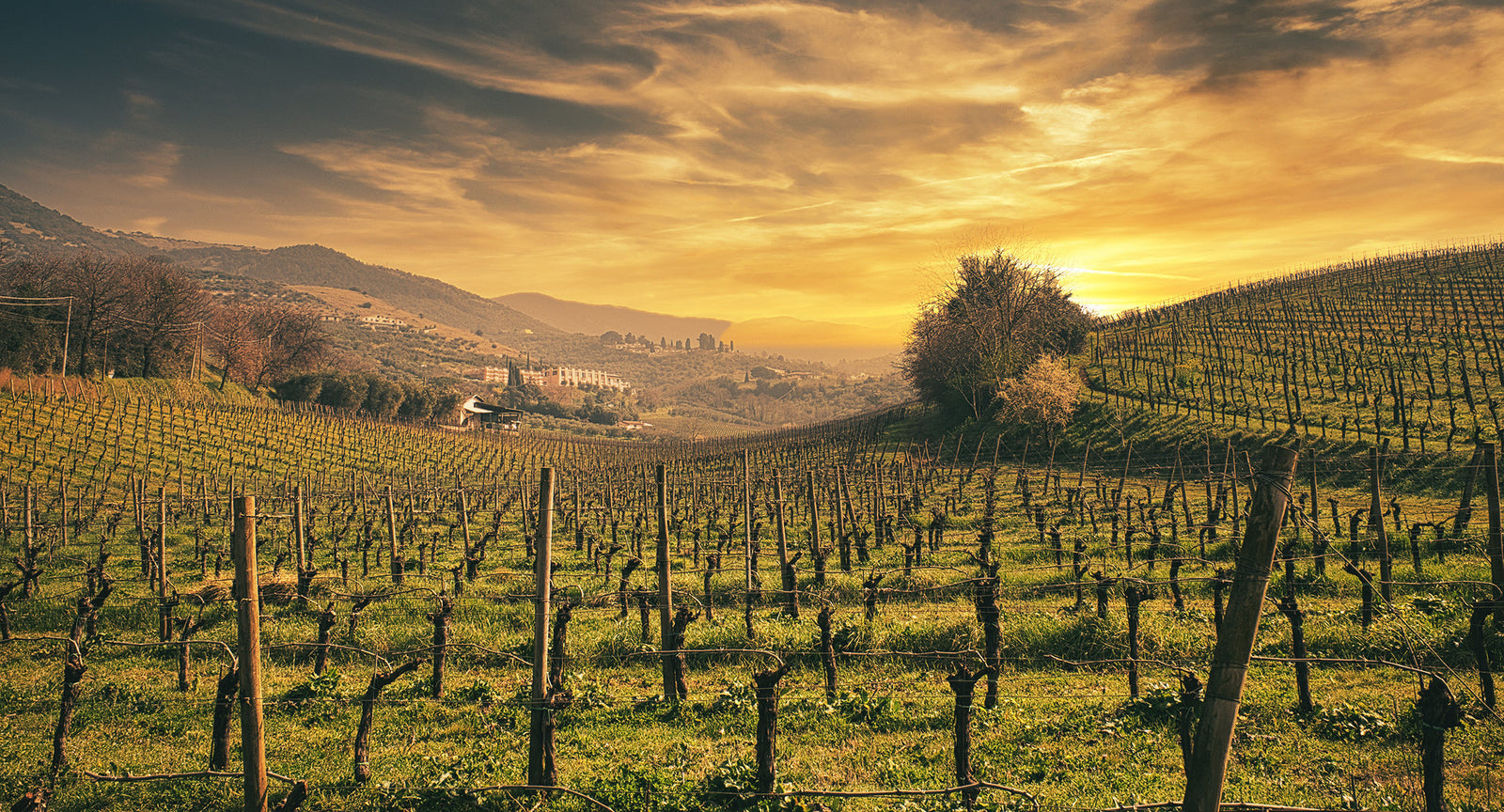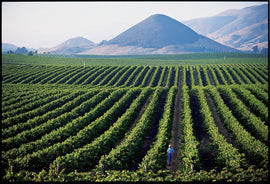LAZIO
Happy New Year! We are inaugurating 2023 with a trip to Lazio, located in west-central Italy, and so-named for the original inhabitants of the area, the “Latini.” The Latini language served as the basis for Latin, from which English derives so many words and concepts. One we should totally use more is palimpsest, which is defined as a document whose original text has been effaced, written over, or otherwise obscured by other text, but remains partially visible. Italy, as you might imagine, possesses a bunch of literal such records: the Institutes of Gaius, the first textbook on Roman law, discovered in 1816 hiding underneath letters by St. Jerome and Gennadius in the Library of Verona Cathedral, for instance. Apply the term’s broader, more metaphorical reverb to the country as a whole though, and you arrive at something that feels fundamental to the place, its history and (of course) the wine. Italy-as-palimpsest makes legible the Babel of gesticulating pasts - recent, living memory, modern, old, ancient, mythic - jostling for your present attention across the breadth of the Boot. Our two wines this month are both products and participants in this argument, excavations of primeval tipples with multiple names, guises and fantastical origins to explore - or ignore, as they both translate just fine without all the lore as well.
Legend has it that after Aeneas escaped the fall of Troy, he sailed around the Apennine Peninsula, and landed in modern-day Lazio. Here, he bore a line of descendents that would eventually lead to Romulus and Remus. These two brothers, the story goes, decided to found the city of Rome on April 23, 753 BC. The more likely and prosaic version is that the city grew from settlements on the Palatine Hill that had sprung up because the area at the base of the hill was ideal for pasture. Either way, Rome has dominated the area and much of the popular imagination; re: Italy ever since, but winemaking in the area actually predates its establishment. The Etruscans, introduced the culture of the vines to the Romans, who were largely shepherds and warriors at this point and more used to labor and conflict than convivial pleasures. Eventually the Romans assimilated not only the Etruscan’s land but also some of their customs and traditions, wine cultivation and appreciation very much among them.
Roman viticulture wasn't built in a day, in other words, but developed over the millenia, primarily in the volcanic hills surrounding the city, an area known as Castelli Romani. Lazio’s overall geography is quite varied, with a wide coastline and sandy beaches extending from Tuscany in the north to Campania in the south, the Apennine mountain range providing protection from cold winds from the north, and several large lakes that constitute their own microclimates. While it has all the natural ingredients for great wine - rich and varied terroir, a mild climate, with decent rainfall and wide daytime/nighttime temperature shifts, and a handful of unique native varietals - wine from Lazio hasn’t always had the greatest reputation. In the latter half of the 20th century especially, industrial farming and concentration on marketable, international grapes earned it a reputation for pedestrian, uninspired products. This is changing though, thanks to a new generation of winemakers with a renewed focus on small production and local varietals. We have two such endeavors this month: Carpineti, farming organically since the 90’s on the aforementioned volcanic soils to produce, in this case,a lovely, minerally white from the indigenous Bellone grape, also known as Arciprete, uva fantastica (fantastic grape) according to Pliny the Elder, and uva panepoiché, to the contadini (peasants) who drank it with their bread.
Our red comes from Monte Cecubi, located in Itri, a small city close to the Gulf of Gaeta in the Tyrrhenian Sea, and boasting its own celestial provenance (its founders were allegedly Castor and Pollux, twins sons of Zeus). This estate is likewise dedicated to organically farming native grapes, here the ancient Roman varietals Serpe and Abuotto, which were used in Cecubo, one of the most prized wines of the Roman age. It enjoyed pride of place at banquets, reserved for last toasts, and it is thought that the word itself is a compound of caecus (blind), and bibere (to drink) so totaling “the wine of the blind one,” for Appio Claudio Cieco, legendary builder of the Appian Way, which runs through the hills of Monti Cecubi.
Salut!
Alan Hicks - Wine Buyer, Noe Valley
|
Marco Carpineti Collesanti Bianco 2021 |
|
|
Region: Lazio Bianco IGT |
About the Winery: Located just south of Rome on an ancient hill community known as Cori, Carpineti’s wines are all certified organic since 1997 (a rarity in Italy both because of the cost of certification and because traditionally producers feel they are making organic wines and don’t need to certify it). Sourcing grapes from the five hills of the area, the volcanic rock ‘tufa’ plays a major role in the delicious wines Marco produces. The grapes for the 2021 Collesanti come from a number of different plots but the most extensive one is the Collesanti Hill, hence the name of the wine. About the Winemaking: Collesanit Hill is 722 feet above sea level with good exposure. Once the grapes are harvested in September, they are put whole through a short maceration, followed by a soft pressing and spontaneous fermentation at controlled temperature and aged in stainless steel. Tasting Notes: Intense, clean and pleasing aromas that start with hints of peach, pineapple and apple, followed by aromas of hazelnut and pear. The mouth has a crisp attack balanced by good body and intense flavors. The finish is persistent with flavors of pineapple, peach and apple. |
|
Winemaker: Marco & Paolo Carpineti |
|
|
Price per bottle / per case $25 / $270 |
|
|
Suggested Food Pairing: Pasta and Risotto dishes with fish and crustaceans Spaghetti a Cacio e Pepe (Pecorino cheese, pepper, and a touch of oil) Veal Saltimbocca (see recipe below) |
|
|
|||
|
Region: IGT Lazio Italy |
About the Winery: Monti Cecubi Winery is located in Itri (Province of Latina, Latium), between woods and forests of cork, on the hills watching Sperlonga Sea. This is the land of the old Vino Cecubo, the Ancient Roman wine. Produced in the area between the towns of Fondi, Itri and Sperlonga (known as "Ager Caecubum"), Cecubo was the most important wine in Ancient Roman times, both during the Republican era and in the Imperial age, and therefor eulogized by many classical poets, such as Horace, Pliny the Elder and Columella. The Estate has retrieved and selected the indigenous grape varieties to bring back Cecubo wine and, utilizing organic farming methods, have reintroduced it in the region. The soil composition, the exposition, the sea influence and the temperature range are the precious elements that give Monti Cecubi vineyards the power to produce intense, fresh, long-lasting and unique wines. About the Winemaking: Vinification takes place with cold pre-fermentation of the skins, followed by a temperature-controlled alcoholic fermentation in stainless steel tanks with several pressing. Malolactic fermentation is carried out in wood, then the wine completes its refining in tonneaux for 9 months. Varietals: 90% Serpe; 10% Abbuoto. Tasting Notes: Intense ruby red color; aromas of cherry and plum with strong notes of spices and pepper and licorice. In the mouth it’s powerful and elegant with enveloping and balanced tannins. |
||
|
Winemaker: Chiara Fabietti |
|||
|
Price per bottle / per case $33 / $356.4 |
|||
|
Suggested Food Pairing: Hearty vegetable stews Roast duck Red meat Aged cheeses and charcuterie |
|||
Saltimbocca alla Romana
Classic Roman veal dish. Saltimbocca literally means “jump in the mouth” which gives you a sense of its immediacy. Works very well plated over some sauteed spinach.
Ingredients
- 8 slices prosciutto
- 8 veal scaloppine, thinly sliced and pounded
- flour spread on a plate for dredging
- 2 tablespoons olive oil
- 2 tablespoons butter
- 8 sage leaves
- 1/2 cup dry white wine
- 1/4 cup chicken broth
- salt and pepper to taste
Instructions
- 1. Place one slice of prosciutto on each veal scaloppine and pound in lightly with a meat pounder
- 2. Heat olive oil in a large sauté pan over medium-high heat. Dredge both sides of the scaloppine in flour to coat, shaking off any excess. Place them prosciutto side down in the pan and cook, turning once, until lightly browned on both sides. Transfer to a warm plate
- 3. Drain oil from pan, place back over heat and add butter. When butter is melted add sage and sauté for one minute
- 4. Add the white wine and scrape loose any bits from bottom of pan, then add the chicken broth and salt and pepper
- 5. Place scaloppine back in pan, prosciutto side up and cook until sauce is reduced by half and scaloppine are heated through
- 6. Transfer veal to serving plates, two scaloppine per person, spoon sauce over top and serve





